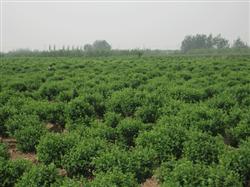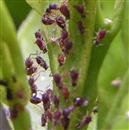How to grow honeysuckle?

How to grow honeysuckle? Honeysuckle is a perennial shrub of honeysuckle family, which can grow all over the country and is unharmed at minus 35-40 ℃. The characteristic stem of the plant is erect, with a height of 1 m to 15 m in the same year after planting. If it is found to be overgrown, it should be cut off to facilitate more lateral branches. The more lateral branches, the higher the yield. 450-500 plants per mu were planted, and the survival rate was more than 98%. Pick once when the buds are budding in the first half of the year, pick once before and after the Mid-Autumn Festival, dry in a ventilated and dry place after harvest, flourish in the second year after planting, and maintain for many years, yielding 100-150 kg of dried flowers per mu. Winter planting before freezing, spring planting flowering to 6.1 node, according to row spacing 1.5 meters, plant spacing 1.2 meters, digging small holes for cultivation. You can survive by pouring some water. Hillsides, wasteland beaches can grow, but also a beautiful bonsai, as a flower ornamental, fragrance and elegant, another grid. Field management of topdressing, loosening soil and weeding at the end of autumn every year, remove the dead branches and leaves at the base of the flower stump, peel off the cork of the branches, and reduce the harm of diseases and insect pests in the coming year. The 30 cm soil around the flower pier is turned deep, and 5-10 kg of soil fertilizer is applied to each pier, and 0.1 kg of superphosphate is applied conditionally, which is formed into a groove shape which is high all around and low in the middle. After the flower pier in the mountain is fertilized, according to the topography, the flower pier will be turned into a fish phosphorus pit or basin shape to facilitate the accumulation of rain and snow. After picking the first stubble flowers, quick-acting fertilizer should be applied in time to increase the yield of the second and third stubble flowers. Winter pruning is generally carried out after all the leaves fall off in winter to before sprouting in the following spring. Winter pruning mainly grasps the principle of "light pruning of strong branches, heavy pruning of weak branches, and cutting of all branches". It is necessary to consider that the plant shape is complete and reasonable after the new branches grow, which is beneficial to ventilation and light transmission. Strong branches should be lightly cut to retain 8-10 buds, weak branches should be heavier, 3-5 pairs of buds should be retained, and cross branches of thin, weak, diseased and winding branches should be completely cut off. Pruning should be tailored to local conditions and plant conditions, and must not be cut across the board. The shearing of plants with good water and fertilizer conditions and strong growth should be retracted and renewed, mainly by thinning and deletion, and by the method of "major operation" to transform and renew the old flower stump. For the young flower plants after planting, it is mainly to cultivate the plant type, generally leaving 3-5 main poles first, and the layout of the main rod should be reasonable, and the top tip should be cut short to promote its thickening. Summer shearing has a great effect on the yield increase of the second and third stubble flowers, the yield is significantly increased when properly pruned, and the flower picking time is relatively concentrated, which is convenient for picking. Generally, after picking the flowers in the previous stubble, the top tip of the vigorous branches should be cut off to control the top dominance to facilitate the germination of new branches; for the twigs with weak growth and yellowing leaves, all the twigs that affect ventilation and light should be cut off. It can be picked 15-20 days after budding. The upper part of the bud is enlarged and bluish white is the suitable time for picking, and the delay will lead to the opening of flowers, affecting the quality and yield of goods. Picking should be in the early morning and morning every day, and the postharvest flowers should be processed and dried in time. The processing methods include natural drying, drying and sulfur fumigation drying. Natural drying is to spread the flowers on a clean ground or mat foil, and the thickness can be about 2 cm depending on the intensity of the sun. If you are exposed to the sun, you can't be caught in the rain before drying. In case of cloudy and rainy days in the flower-picking season, it is difficult to guarantee the quality of the goods. The drying process is carried out in the drying room, heating the room temperature to 45 ℃, putting the flowers on the foil basket, drying up to 60 ℃, several times dehumidification and airtight station window until drying. Click to get more honeysuckle planting technology click to get more medicinal material planting technology
- Prev

What are the insect pests in planting honeysuckle?
What are the insect pests in planting honeysuckle? Please introduce the control method of honeysuckle the main pest is aphids, in the high temperature and rainy environment, often harm new leaves, rattan tips, curl, affect growth. It is common to spray 3000 times of dimethoate emulsion or 1000 times of imidophos emulsion. In addition, there are two kinds of simplicity.
- Next

How much is a fig sapling? Introduction to the price and planting method of fig seedlings
Figs are the fruits of deciduous shrubs of the genus Ficus of Moraceae, also known as Ampelopsis grossedentata, Milk berries, Pingxian Fruit, etc., originally from the Mediterranean coast. China was introduced from Persia in the Tang Dynasty and is now cultivated in the north and south, especially in the south. Its cultivation value is very high and the benefit is very obvious.
Related
- Fuxing push coffee new agricultural production and marketing class: lack of small-scale processing plants
- Jujube rice field leisure farm deep ploughing Yilan for five years to create a space for organic food and play
- Nongyu Farm-A trial of organic papaya for brave women with advanced technology
- Four points for attention in the prevention and control of diseases and insect pests of edible fungi
- How to add nutrient solution to Edible Fungi
- Is there any good way to control edible fungus mites?
- Open Inoculation Technology of Edible Fungi
- Is there any clever way to use fertilizer for edible fungus in winter?
- What agents are used to kill the pathogens of edible fungi in the mushroom shed?
- Rapid drying of Edible Fungi

